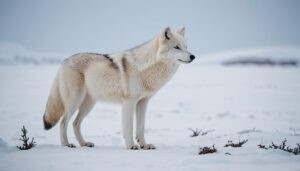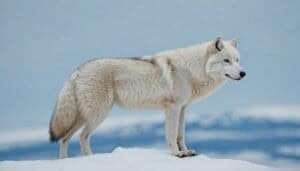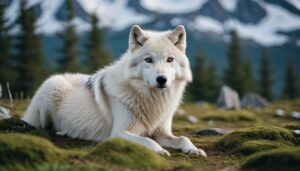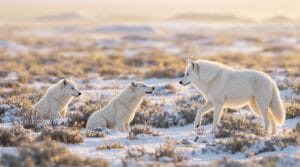Introduction
Arctic wolves are fascinating creatures with complex communication methods essential for their survival. This article explores the various ways Arctic wolves communicate, including vocalizations, body language, and scent marking
Additionally, it delves into the threats posed by climate change and human activities to their communication channels and examines conservation efforts aimed at protecting these vital aspects of their lives
Communication Methods of Arctic Wolves
Arctic wolves, native to the harsh environments of the Arctic regions, have evolved sophisticated communication methods crucial for their survival and social cohesion. These methods include vocalizations, body language, and scent marking, each serving distinct purposes in their daily lives and interactions
Vocalizations in Arctic Wolves
Vocalizations are a primary communication method for Arctic wolves. They use a variety of sounds, including howls, barks, growls, and whines, to convey different messages
Howling is perhaps the most iconic vocalization, serving multiple purposes such as coordinating pack movements, establishing territory, and maintaining social bonds. According to the National Park Service, wolf howls can be heard over several miles, especially in open tundra environments
Howling also helps wolves to gather the pack when they are dispersed, often in response to environmental changes or the presence of potential threats. Each wolf has a unique howl that can be recognized by other members of the pack, allowing for individual identification within the group
In addition to howling, barks and growls are often used in more immediate and close-range situations, such as warning intruders or expressing aggression or submission
Body Language and Gestures
Body language is another crucial component of communication among Arctic wolves. They rely heavily on visual signals to express their emotions and intentions. Common gestures include tail positions, ear postures, and facial expressions
For instance, a dominant wolf will often hold its tail and ears high, while a submissive wolf may tuck its tail between its legs and flatten its ears
Facial expressions, such as baring teeth or relaxing the mouth, can indicate aggression, fear, or contentment. Posture is also significant; a confident, dominant wolf will stand tall and rigid, while a submissive one will crouch or lie down. These body language cues help maintain pack hierarchy and prevent conflicts, ensuring the pack functions smoothly and cohesively
Scent Marking and Territory
Scent marking is vital for Arctic wolves to establish and defend their territory. Wolves have scent glands on their feet, tails, and anal regions, which they use to mark objects like trees, rocks, and the ground
This marking behavior communicates the presence and boundaries of their territory to other wolves and potential intruders
Scent marking also plays a role in intra-pack communication, helping members locate each other and reinforcing social bonds. The unique chemical composition of each wolf’s scent allows individuals to recognize one another and assess information about age, sex, and reproductive status
According to studies, scent marking is more frequent during breeding season, indicating its role in reproduction and pack dynamics
Threats to Arctic Wolves’ Communication Channels
Arctic wolves’ communication channels face significant threats from both natural and human-induced changes in their environment. These threats can disrupt their ability to communicate effectively, which is crucial for their survival and social structure
Climate Change Effects
Climate change poses a major threat to Arctic wolves by altering their habitat and the conditions they rely on for survival. Melting ice and permafrost, along with changing snow patterns, can disrupt the wolves’ ability to hunt and travel. The loss of sea ice, for example, forces wolves to cover greater distances to find prey, which can interfere with their communication and coordination
Changes in prey availability due to shifting climate conditions also affect wolf communication. As prey species like caribou and musk oxen migrate or decline in numbers, wolves must adapt their hunting strategies, often requiring enhanced coordination and communication within the pack
The unpredictability of prey locations can lead to increased stress and competition, potentially straining communication channels
Additionally, climate change can influence the acoustic environment of the Arctic. Increased wind and other weather phenomena may interfere with the wolves’ vocalizations, making it harder for them to communicate over long distances. Such disruptions can affect their ability to maintain social bonds and coordinate activities effectively
Human Activities and Noise Pollution
Human activities in the Arctic, such as industrial development, mining, and oil exploration, introduce significant noise pollution that can interfere with wolf communication
Noise from machinery, vehicles, and human presence can drown out the wolves’ vocalizations, making it difficult for them to hear each other and respond appropriately. This noise pollution can lead to increased stress and confusion among wolf packs
Human activities also lead to habitat fragmentation and encroachment. As human settlements and infrastructure expand into wolf territories, the natural landscape becomes divided, reducing the available space for wolves to roam and communicate
Fragmented habitats force wolves into smaller, isolated areas, limiting their ability to establish and defend territories effectively. This encroachment can disrupt the natural social structure of wolf packs and impede their communication
Habitat Encroachment and Fragmentation
Habitat encroachment, often a result of expanding human activities, directly threatens Arctic wolves by reducing the size and quality of their natural habitat
As roads, pipelines, and settlements spread into previously untouched regions, the continuous expanses of wilderness that wolves rely on become fragmented. This fragmentation disrupts the wolves’ ability to travel, hunt, and communicate across large distances
Smaller, isolated habitats also mean that wolves are more likely to come into contact with human activities, increasing the risk of conflict and reducing their ability to maintain stable packs. The disruption of their natural territories can lead to increased competition for resources and reduced reproductive success, further endangering their populations
Conservation Efforts and Solutions
Conservation efforts are essential to mitigate the threats to Arctic wolves’ communication channels. Protecting large, contiguous areas of habitat from development and industrial activities is crucial for maintaining the wolves’ natural environment and allowing them to communicate effectively
Establishing protected areas and wildlife corridors can help ensure that wolves have the space they need to roam, hunt, and communicate without interference
Efforts to reduce noise pollution in critical wolf habitats are also important. Implementing noise-reduction measures in industrial operations and limiting human access to sensitive areas can help preserve the acoustic environment that wolves rely on for communication
Additionally, raising awareness about the impact of human activities on Arctic wolves and promoting coexistence strategies can contribute to the conservation of these vital communication channels
Conservation Efforts and Solutions
Conservation efforts for Arctic wolves focus on mitigating the threats to their communication channels and overall survival. These efforts involve protecting their natural habitats, reducing human-induced disturbances, and promoting sustainable coexistence between wolves and human activities
Protecting Habitat
One of the most critical aspects of conserving Arctic wolves is protecting their natural habitats. Efforts to establish and maintain protected areas, such as national parks and wildlife reserves, are essential. These protected areas ensure that wolves have the space they need to roam, hunt, and communicate without interference from human activities
In Canada, for example, the establishment of protected areas in the Northwest Territories and Nunavut has been a significant step toward conserving the Arctic wolf population. These regions provide vast, undisturbed tracts of land where wolves can maintain their natural behaviors and communication methods
Additionally, creating wildlife corridors that connect fragmented habitats allows wolves to move freely between different areas. These corridors help maintain genetic diversity and enable wolves to access various prey resources, reducing the stress on their communication channels caused by habitat fragmentation
Reducing Noise Pollution
Noise pollution from industrial activities is a significant threat to Arctic wolves’ communication. To mitigate this, conservationists and policymakers are working to implement noise-reduction measures in critical wolf habitats
For instance, regulations that limit the noise levels of machinery and vehicles used in mining and oil exploration can help preserve the natural acoustic environment
Another effective strategy is establishing buffer zones around critical wolf habitats where industrial activities are restricted or prohibited. These buffer zones can help minimize the impact of noise pollution on wolf communication and reduce the overall stress on wolf populations
Promoting Sustainable Coexistence
Educating local communities and industries about the importance of Arctic wolves and the need to protect their communication channels is vital. Conservation programs often involve outreach and education efforts to raise awareness about the impacts of human activities on wolves and promote sustainable practices
For example, community-based conservation initiatives in the Arctic regions work with indigenous peoples and local residents to develop strategies that balance economic development with wildlife conservation
These initiatives can include promoting ecotourism, which provides economic benefits to local communities while encouraging the protection of wolf habitats
Monitoring and Research
Ongoing monitoring and research are crucial for understanding the impacts of environmental changes and human activities on Arctic wolves
By tracking wolf populations, their movements, and their communication behaviors, researchers can gather data to inform conservation strategies and measure the effectiveness of implemented measures
Technological advancements, such as GPS collars and remote sensing, have enhanced the ability to monitor wolf populations in remote and harsh Arctic environments. This data helps conservationists identify critical habitats, assess the impacts of climate change, and adapt conservation efforts to changing conditions
Collaborative Efforts
Effective conservation of Arctic wolves requires collaboration between governments, conservation organizations, indigenous communities, and the private sector. International cooperation is also essential, as the range of Arctic wolves often spans multiple countries
Collaborative efforts can lead to the development of comprehensive conservation plans that address the various threats to Arctic wolves and their communication channels. By working together, stakeholders can pool resources, share knowledge, and implement coordinated actions to protect these iconic animals
Conclusion
The communication methods of Arctic wolves are vital for their survival, enabling them to coordinate hunting, maintain social bonds, and establish territories. These methods include vocalizations, body language, and scent marking. However, Arctic wolves face significant threats to their communication channels due to climate change and human activities
Climate change disrupts their habitats and prey availability, affecting their ability to communicate and coordinate effectively. Human-induced noise pollution and habitat fragmentation further threaten their communication, making it difficult for wolves to maintain social cohesion and defend their territories
Conservation efforts are crucial to protecting Arctic wolves and their communication channels. These efforts involve protecting habitats, reducing noise pollution, promoting sustainable coexistence, and conducting ongoing research and monitoring. Collaborative actions among governments, conservation organizations, indigenous communities, and the private sector are essential to ensure the survival of Arctic wolves and the preservation of their intricate communication methods
By addressing the threats and implementing effective conservation strategies, we can help safeguard the future of Arctic wolves and maintain the natural balance of their Arctic ecosystems











